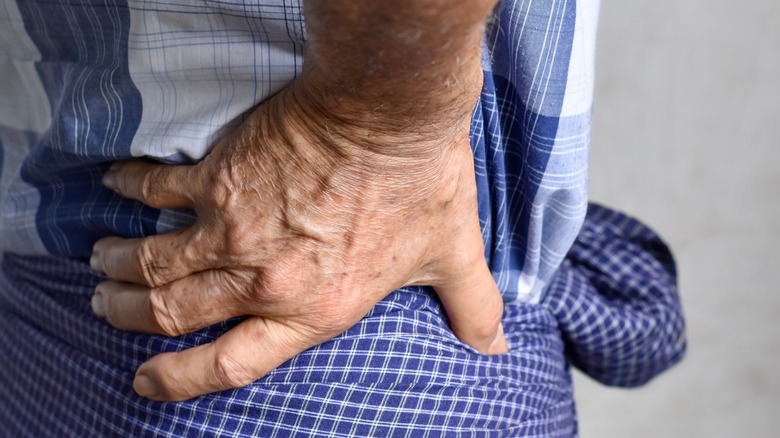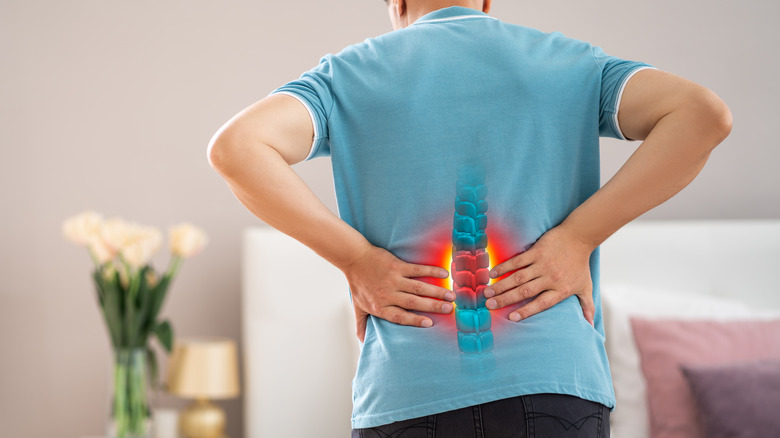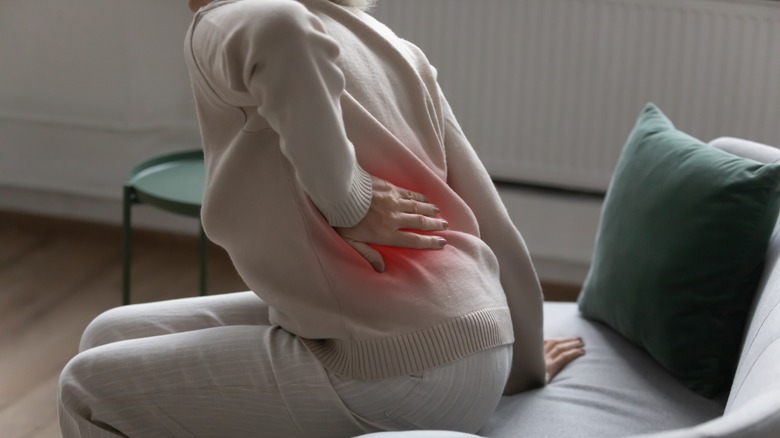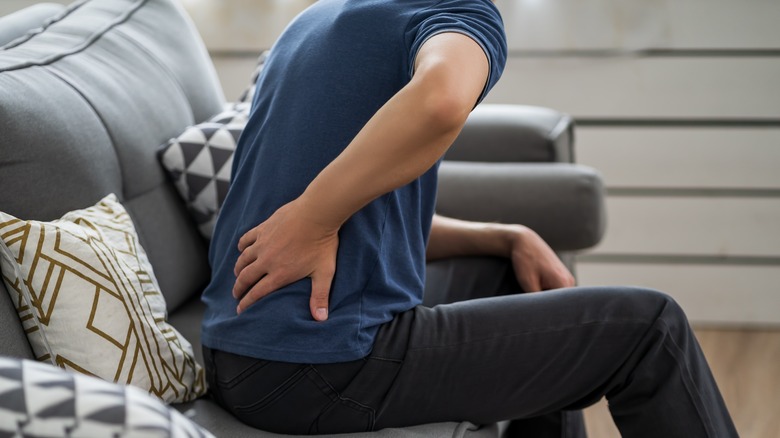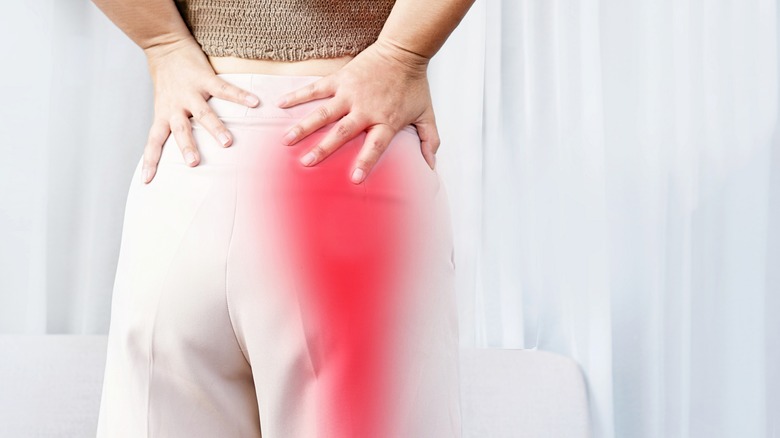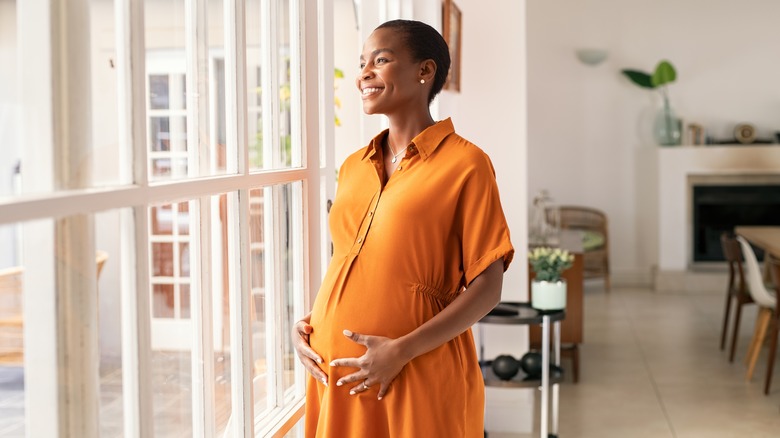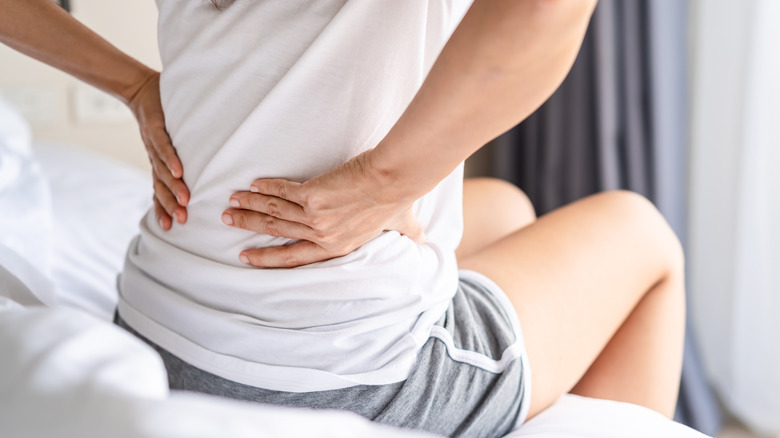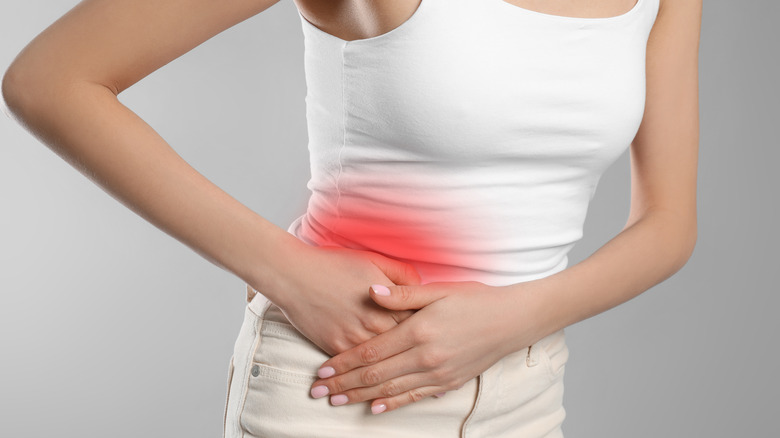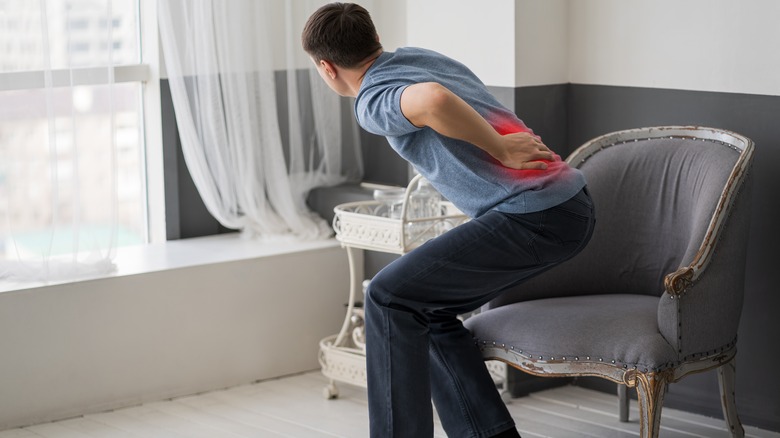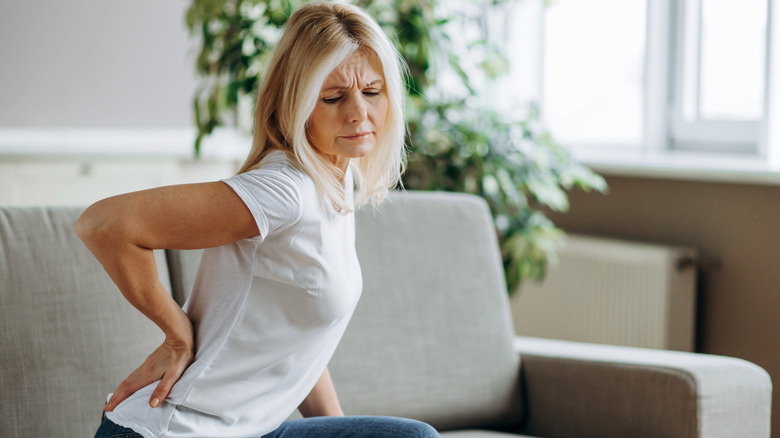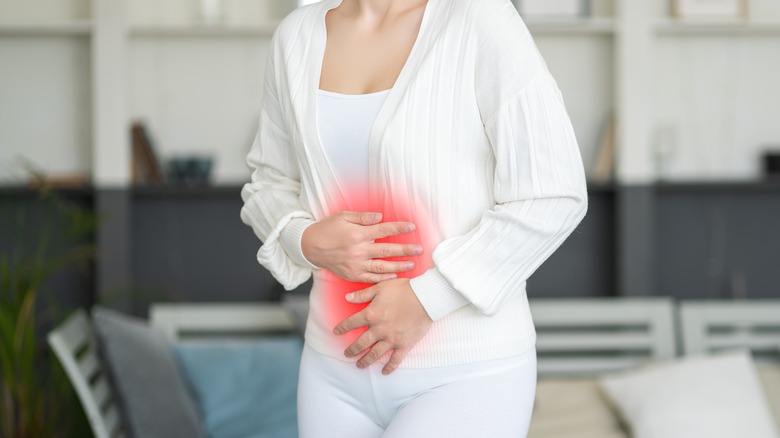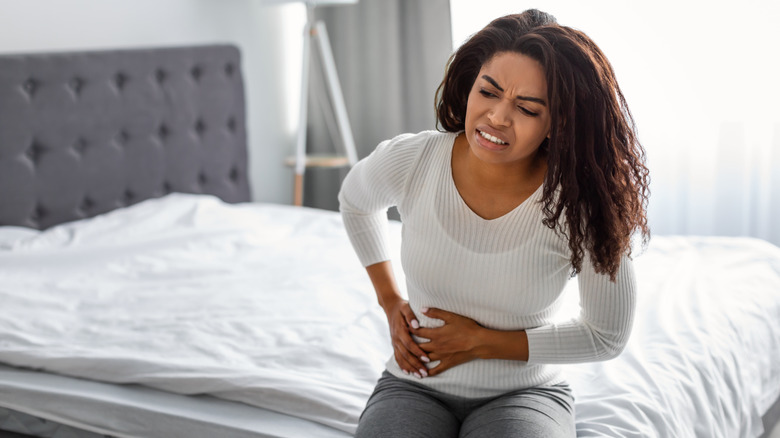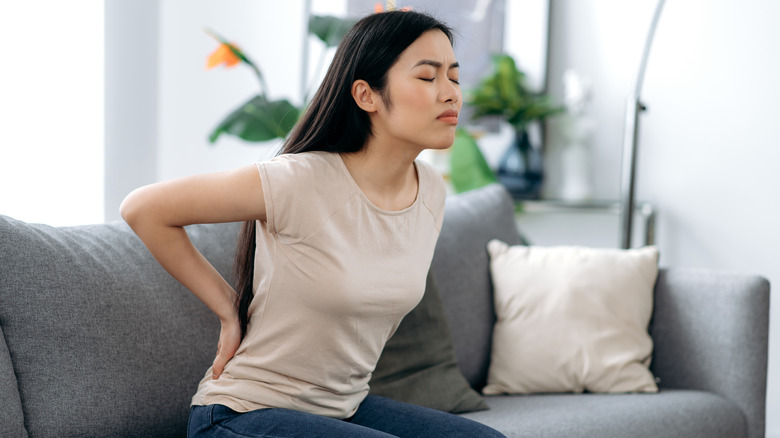Why You May Have Lower Back Pain On Just The Right Side
About 80% of people will experience pain and discomfort in their lower backs at some point in their lives (via Cleveland Clinic). Your pain may be mild, moderate, or severe, and it may be short-lived, reoccurring, or chronic. Back pain is more common as you age, and people over the age of 30 are more prone to experiencing it. This is because the rubbery discs in between the vertebrae start to wear down with age. As they weaken, your risk for pain, stiffness, strains, and sprains increases. Other common causes of low back pain include being overweight, which puts pressure on the spine, living a sedentary lifestyle, and having a physically demanding job. Musculoskeletal problems and certain physical and mental illness can also be factors.
Low back pain isn't always symmetrical, meaning you may feel it on the right side but not on the left. In many cases, this is perfectly normal and nothing to worry about. Your best bet is to see your physician who can rule out any of the riskier causes and help you formulate a plan to treat your pain.
Strains and sprains
Strains and sprains are the most common and benign reasons for lower back pain on one side (via Cleveland Clinic). A strain sustains injury to either a tendon or a muscle. Tendons connect muscles to bones and are primarily composed of substances called collagen and elastin (via 220Triathlon). The muscles and tendons of the lower spine are at risk of tearing, twisting, or pulling, which can result in a back strain (via Cleveland Clinic). Common causes of lower strains include poor lifting technique or overloading or overworking the muscles of the low back. Strains can be chronic, resulting from repetitive movements that cause stress to the muscles and tendons over time.
A sprain is an injury to a ligament. These are tough tissues that link bones at a joint and provide joint stability. Sprains are typically the result of trauma, from a fall, an impact to the body, or an acute twisting motion that moves a joint out of its habitual position.
Factors that can increase the risk for these injuries include excessive curvature of the low back, being overweight, and having weakened core muscles and tightness in the hamstrings. Sports like lifting weights and playing football also put you at increased risk of a lower back strain on one side. Treatment for strains and sprains includes rest and the use of ice and compression in the first 48 hours after the injury. Anti-inflammatory medications can also help ease pain and swelling.
Ankylosing spondylitis
Ankylosing spondylitis is a form of arthritis that affects the sacroiliac joints at the bottom of the spine (via Cleveland Clinic). Inflammation in these joints and the ligaments that support them cause sacroiliitis, which is often an early sign of this condition. The pain may be unilateral or one-sided (via WebMD). It's especially common for the pain to be felt only on one side in the early stages of the condition. Spondylitis occurs when the inflammation extends from the joints to the vertebrae (via Cleveland Clinic). Eventually, new bone may form and fuse vertebrae together, which can cause rigidity in the spine. This is known as ankylosis.
Ankylosing spondylitis can affect anyone, but some people are more likely to experience it. This includes people with a particular gene and a family history of the condition, and people who have other conditions including ulcerative colitis, psoriasis, or Crohn's disease, according to the National Institutes of Health (NIH). You're also more likely to get ankylosing spondylitis if you are under the age of 45.
In addition to lower back pain on one or both sides, other symptoms may include pain, inflammation, and stiffness in joints in the shoulders, knees, feet, and ribs; changes in vision and eye pain due to inflammation; fatigue; appetite and weight loss; skin rashes; abdominal pain; and loose stool. Ankylosing spondylitis can't be cured. Treatment includes managing the symptoms to relieve pain and inflammation, encourage good posture, and keep the disease from progressing. Your doctor may recommend medication, physical therapy, or surgery.
Spinal stenosis
Spinal stenosis results from pressure placed on the spinal cord when the area inside the backbone is not large enough (via Johns Hopkins Medicine). Stenosis, which means "narrowing," can occur anywhere along the spine, but it is most likely to affect the lumbar spine, or lower back. Age and the development of osteoarthritis is the most common cause of this condition. People who are over age 50 are at the highest risk, and women are more prone to developing spinal stenosis than men. Some other conditions and situations can bring on spinal stenosis, including a spinal injury, a naturally narrow spinal canal, a tumor in the spine, specific bone diseases, rheumatoid arthritis, and past spinal surgery.
Primary symptoms include pain, numbness, and cramps in the back and legs, and they often only affect one side of the body. You may also have discomfort in your arms, neck, or shoulders. You may have difficulty walking longer distances, or feel like you need to lean forward to release low back pressure. More severe cases may cause problems with bowel and bladder control.
Spinal stenosis can't be cured, but it can be managed via medications to relieve inflammation and swelling. Physical therapy can help strengthen the back, abdominal and leg muscles. Using a back brace, stretching and having massages can also help. Surgery may sometimes be recommended, but is typically not necessary.
Lumbar radiculopathy and sciatica
Radiculopathy is a condition caused by a pinched nerve root anywhere along the spine (via Johns Hopkins Medicine). When it occurs in the lower back it is called lumbar radiculopathy. The pinched nerve becomes irritated and inflamed and leads to pain that can be severe. Typically it only causes symptoms on one side of the back. Aging and the resulting wear and tear on the spinal discs is a common cause. This can lead to spinal stenosis, or a narrowing of the spinal canal. An injury to the lumbar spine, being overweight, a herniated disc, bone spurs, and spinal instability and resulting slipped vertebrae are also common causes (via UC Health).
Pain in the lower back is the primary symptom of lumbar radiculopathy. Often pain will extend down into the hips, glutes, hamstrings, calf, and foot. When this happens, it's referred to as sciatica. In this case, the sciatic nerve that runs from the low back down the back of the leg is the nerve that is being pinched (via the Mayo Clinic). Other symptoms include numbness, weakness, and problems moving your foot or leg.
Treatment typically includes rest, reducing body weight, anti-inflammatory medications, and physical therapy. In some cases, steroid injections can be helpful. You can take some steps to prevent lumbar radiculopathy, including remaining active and fit and managing your weight (via Johns Hopkins Medicine). Practicing good posture while sitting, engaging in sports and exercise, and lifting heavy objects can also help.
Pregnancy
Pregnant women often experience low back pain, especially early on in their term, according to the National Health Service (NHS). During pregnancy, ligaments that connect bones to other bones soften in preparation for giving birth. This can cause instability in the lower back and pelvis that leads to lordosis, or an excess reverse curvature of the spine that places pressure on the joints, ligaments, muscles, and discs of the low back (via Spine-health). As a result, the psoas muscle along the front of the pelvis becomes shortened and pulls on the lower back, causing further discomfort (via The Advanced Spine Center).
To prevent and ease back pain during pregnancy, don't lift heavy objects (via NHS). When retrieving something from the floor, bend at the knees, not the hips, and keep your spine erect as you rise up. Avoid twisting at the torso, and instead turn your entire body, feet included. Wear flat shoes for proper support. When sitting, support your spine with pillows, and sleep on a mattress with firm support. Warm baths, massages, and getting plenty of rest can also help.
If your pain is severe, talk with your doctor or an obstetric physiotherapist. Certain exercises can help alleviate your pain. If you are in your second or third trimester, you have fever, blood coming from the vagina, painful urination, or pain under your ribs, you should contact your doctor immediately. If you experience a loss of feeling in your legs, buttocks, or genitals, seek emergency care.
Endometriosis
Endometriosis is a female-specific condition in which endometrium — the tissue that lines the inside of the uterus — grows on the exterior of the uterus (via WebMD). Approximately 1 in 10 women and girls of reproductive age are affected by this condition globally (via the World Health Organization). Endometriosis is a chronic inflammatory disease that causes the formation of lesions in the pelvis and in other areas of the body. In addition to the growth of endometrium outside the uterus, lesions may develop in the ovaries, the recto-vaginal septum, bladder, and bowel. Rarely, endometriosis lesions develop outside of the pelvic area.
Back pain is common symptom of endometriosis. Endometrial cells may adhere to the lower beck or the pelvis, exerting pressure. Sciatic endometriosis places pressure on the sciatic nerve that extends from the lower back down the back of the leg (vis the Center for Endometriosis Care). Sciatica is commonly only experienced on one side. Endometriosis typically affects the sciatic nerve on the left side, but it is also possible on the right side.
Other symptoms of endometriosis include painful menstruation; recurring pain in the pelvic area; pain during or after sex and during bowel movements and urination; fatigue; anxiety and depression; bloating in the abdomen; and nausea. Endometriosis can't be cured, but it can be managed to reduce the impact of symptoms. Typically this includes taking prescription pain medications, surgical procedures to remove lesions, and the use of hormonal birth control to prevent regrowth.
Appendicitis
Approximately 5-9% of people will experience appendicitis at some point in their lives (via NIH). The primary symptom is, of course, severe abdominal pain, but the discomfort of appendicitis isn't restricted to the abdomen — it can also cause back pain. Because the appendix is located on the right side of the lower abdomen, any low back pain will also occur on the right side.
Inflammation in the appendix, a small organ that extends from the colon, is the cause of appendicitis (via the Mayo Clinic). The most common cause of is a bacterial infection in the lining of the appendix. This can lead to inflammation, swelling, and a buildup of pus. Pain usually first appears in the navel area and then migrates to other areas. The pain may be mild at first but gradually worsens and can become severe. Walking, coughing and other movements may make the pain worse. Other signs and symptoms of appendicitis include nausea, vomiting, low appetite, fever, diarrhea or constipation, abdominal bloating, and gas.
Treatment typically involves surgical removal of the appendix, and often a course of antibiotics. It's important to seek immediate medical attention if you have severe stomach pain. If left untreated, complications can occur that may cause the appendix to burst, which can be life-threatening.
Kidney stones
Kidney stones are responsible for more than 500,000 emergency room visits annually (via the National Kidney Foundation). Your kidneys transform waste in the bloodstream to urine so it can removed from your body. Sometimes, waste can build up in your urine, and your body will stop producing enough urine to clear the waste. This causes crystals to form in your kidneys, and these crystals draw other waste. This combination forms a solid kidney stone that can continue to grow. Kidney stones range from the size of a grain of sand to the size of a golf ball (via American Kidney Fund).
You are at a higher risk of kidney stones if you have already had one, have a family history of kidney stones, are chronically dehydrated, are overweight, have had intestinal surgery, or eat large amounts of protein, salt, and sugar. Several underlying health conditions can also raise the risk of kidney stones.
Small kidney stones may go unnoticed and naturally pass via urination. Larger kidney stones can cause complications and uncomfortable symptoms, including painful urination, blood in urine, foul-smelling or cloudy urine, an unrelenting stomachache, vomiting, fever, and chills. They can also cause a stabbing pain in your lower abdomen and your back. Kidney stones that don't pass on their own may need treated surgically. Lithotripsy, in which the stone is broken apart by shockwaves, and ureteroscopy, in which the stone is manually removed or broken up by laser, are two common procedures.
Ulcerative colitis
The most common symptoms of ulcerative colitis are gastrointestinal. A less common, but still potential, symptom is back pain. Ulcerative colitis causes inflammation the can spread to the spine and other joints.
As may as 900,000 people in the United States are affected by ulcerative colitis (via NIH). It's one type of chronic inflammatory bowel diseases, which also include Crohn's disease and microscopic colitis. Abnormal immune system responses lead to inflammation of the lining of the large intestine, as well as the formation of ulcers. In addition to back pain, common symptoms include diarrhea that often contains blood or pus, blood in stool, pain and cramping in the abdomen, rectal pain, weight loss, fever, and fatigue. You may also feel an urgency to have a bowel movement, but then not be able to have one.
Medication is the frontline treatment for ulcerative colitis, per the NIH. Medication reduces intestinal inflammation. Symptoms may disappear, but lifetime medications are usually required in lieu of surgical removal of the rectum and colon. If you have colorectal cancer, symptoms that don't abate with medication, or life-threatening complications, your doctor may recommend surgery.
Pelvic inflammatory disease
There are many reasons for pain in the pelvis, but one that is one the rise is pelvic inflammatory disease, or PID (via NIH). An infection of the female reproductive tract, PID is caused by bacteria; most commonly, it's the result of sexually transmitted infections, including chlamydia and gonorrhea (via the Mayo Clinic). It may also occur anytime the normal barrier of the cervix is disturbed and bacteria is able to enter, such as during your period or after having a baby, a miscarriage, or an abortion — although this is less common.
Common symptoms of PID include pain in the lower abdominal region, abnormal vaginal discharge with a foul odor, burning when urinating, abnormal bleeding, pain or bleeding during sex, and a fever. The abdominal pain from PID can also spread to your back. If you're at a higher risk of this condition, and you have back pain along with one or more of the common symptoms, PID could be to blame. Risk factors include being sexually active under age 26, having an untreated STD, having multiple sex partners, having a partner who has multiple sex partners, and douching. Having had PID in the past also increases your risk.
Getting treated for PID early is important, because complications can arise, including scar tissue formation on the fallopian tubes, ectopic pregnancy, and infertility. PID is typically treated with a course of antibiotics (via NHS).
Urinary tract infection
Urinary tract infections (UTIs) are the result of bacteria entering the urethra and causing infection in the urinary tract, according to the Centers for Disease Control and Prevention (CDC). They are very common, and women are more often affected than men. Bladder infections, or cystitis, are the most frequent type of UTI, and symptoms include pain and burning during urination; frequent need to urinate, even when your bladder is empty; blood in your urine, and cramping in the lower abdominal area or groin. A more serious, and less common, type of UTI is a kidney infection. This is the type that is likely to cause back pain on one side. Other symptoms include fever, chills, nausea, and vomiting.
In addition to being female, several other factors can increase your risk of contracting a UTI. These include previously having a UTI, being sexually active, being pregnant, having structural abnormalities in the urinary tract, and having poor hygiene. Any alteration of the bacteria inhabiting the vagina, such as during menopause or when using spermicides, can also increase your risk. Age is also a factor, with UTIs being more common in young children and older adults.
UTIs can be treated with a course of antibiotics. To prevent UTIs, wipe front to back, swap baths for showers, stay hydrated, urinate after sex, and avoid frequent use of douches, sprays, and powders around your genitals.
Uterine fibroids
Uterine fibroids are tumors (99% non-cancerous) that grow in the uterus and vary in size, possibly growing to the size of a melon (via Johns Hopkins Medicine). It's not known what causes fibroids, but it is thought that they are formed by abnormal muscles cells in the uterus. Lower back pain is a common symptom of fibroids, depending on where they are located. If they grow on the back of the uterus, they can place pressure on the nerves of the lower spine. In a survey of women with fibroids, almost 70% of respondents reported lower back pain as a symptom (via NIH).
Back pain associated with fibroids is typically dull and achy, like a strained muscle, and it may worsen if you sit or stand for too long. Muscle spasms, pain in the hips and legs, chronic stiffness, numbness or pins and needles in your legs, and lower back weakness are other back-related symptoms of uterine fibroids. This may be accompanied by heavy or long menstruation, abnormal bleeding outside of menstruation, abdominal pain and bloating, pain in the pelvic region and bladder and bowel symptoms, such as frequent urination or constipation.
If symptoms do not disturb your quality of life, your healthcare provider will typically advise "watching and waiting." For more serious cases, medication to control pain and hormonal treatments, as well as surgery to remove the fibroid may be recommended.

